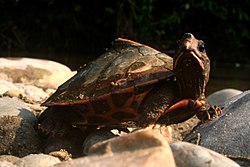| Assam roofed turtle | |
|---|---|
 | |
| Scientific classification | |
| Kingdom: | Animalia |
| Phylum: | Chordata |
| Class: | Reptilia |
| Order: | Testudines |
| Suborder: | Cryptodira |
| Family: | Geoemydidae |
| Genus: | Pangshura |
| Species: | P. sylhetensis |
| Binomial name | |
| Pangshura sylhetensis Jerdon, 1870 | |
| Synonyms [3] | |
| |
The Assam roofed turtle or Sylhet roofed turtle (Pangshura sylhetensis) is a turtle species of the family Geoemydidae found in the Brahmaputra-Meghna drainage in (Assam), Terai Arc Landscape region of India and parts of eastern Bangladesh (Sylhet). It was formerly placed in the genus Batagur and the defunct genus Kachuga .



